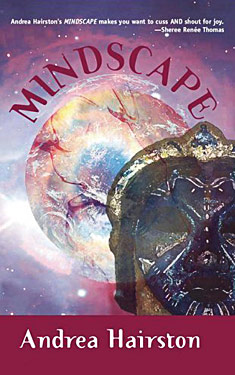WoGF Review: Mindscape by Andrea Hairston
 Rae McCausland (ParallelWorlds) was raised on speculative fiction and dedicated most of her teenage years to the dream of writing fantasy novels. During her college years, her interests shifted toward science fiction thanks to Star Trek and Isaac Asimov’s robot stories. She writes reviews for Parallel Worlds Magazine as a way of building connections between the perspectives of fellow sci-fi nerds and people of marginalized gender and sexual identities.
Rae McCausland (ParallelWorlds) was raised on speculative fiction and dedicated most of her teenage years to the dream of writing fantasy novels. During her college years, her interests shifted toward science fiction thanks to Star Trek and Isaac Asimov’s robot stories. She writes reviews for Parallel Worlds Magazine as a way of building connections between the perspectives of fellow sci-fi nerds and people of marginalized gender and sexual identities.
 Aqueduct Press, 2006
Aqueduct Press, 2006
Intended Audience: Adult
Sexual content: Explicit
Ace/Genderqueer characters: Yes
Rating: R for language, violence, and sex
Writing style: 1/5
Likable characters: 3/5
Plot/Concepts: 2/5
When the Barrier came—a cosmic and organic life-form, restricting travel between arbitrary zones on Earth—the world changed forever. A hundred years later, Celestina dies to bring an end to the wars between the zones, and five years after that, the treaty is still not being lived as it should be. Instead, many of the zones reject the treaty, already too set in their individual agendas and cultures. Soldiers, actors, directors, ambassadors and Vermittler (humans who can commune with the Barrier) are thrown into a conflict with and against one another that will decide the future of Earth.
At 445 pages, Mindscape is a fairly hefty read. I wasn’t sure what to expect when I picked it up, as the synopsis I’d read was fairly vague. I soon learned that this was for good reason. I’m not sure if Hairston was trying to pull the reader into a particular “mindscape” via her writing style, or if the muddled feel of it was accidental, but I was nearly a hundred pages in before I had any sort of clue what was going on. In the first scene, the reader is dumped right into the thick of an important political event, with foreign names and words being thrown around helter-skelter with very little indication of which ones are important or what they really mean. Then comes the realization that there is no single main character; the reader is bounced back and forth between first and third-person perspectives and multiple points of view. The only explanation of anything comes in dialogue or flashbacks, which could be real, or could be visions or legends—it’s impossible to tell for sure. I can appreciate the effort taken to teach by immersion, but in this case I would have preferred an info-dump over feeling so lost for the entirety of the book.



















 Full Details
Full Details

